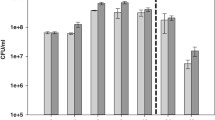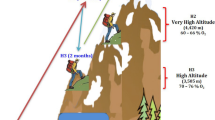Abstract
The present study was conducted to investigate the influence of microgravity on human gut microbiota using 16S rRNA gene sequencing in vitro. The diamagnetic material magnetic levitation method was used to simulate weightless environment. The human gut microbiota was cultured under two different conditions: normal gravity (1 g), and simulated microgravity (0 g), which showed that both the richness (P = 0.04) and diversity (P = 0.0002) of human gut microbiota were significantly altered. As compared to the normal gravity, the simulated microgravity significantly reduced abundance of bacteria related to anti-inflammatory effects, such as Subdoligranulum, Faecalibacterium, Fusicatenibacter, Butyricicoccus, and Lachnospiraceae-NK4A136-0 group (P < 0.05), while significantly increased that of Alistipes and Eubacterium-Ventriosum-group (P < 0.05). Moreover, the Spearman’s correlation analysis showed that there were more significantly correlated species (|r|≥ 0.5, P < 0.05) in normal gravity than that in the simulated microgravity. KEGG pathway analysis revealed that the microgravity significantly (P < 0.05) affected the metabolism of gut microbiota, such as the metabolism of pyrimidine, fatty acids, glyoxylate and dicarboxylate, peptidoglycan biosynthesis, and carbon fixation in photosynthetic organisms. These results suggested that the exposure to a microgravity environment might induce disturbances in human gut microbiota.
Key points
• Using 16sRNA gene sequencing technology, it was found that magnetic levitation-simulated microgravity had varying degrees of influence on the abundance, diversity, species correlation, and KEGG pathways of human intestinal microbes.
• Digital PCR can improve the detection rate of microorganisms with low abundance.








Similar content being viewed by others
Data availability
All relevant data for this study are available from the corresponding authors.
References
Beaugnon E, Tournier R (1991) Levitation of organic materials. Nature 349:470–470
Cani PD, Bibiloni R, Knauf C, Neyrinck AM, Neyrinck AM, Delzenne NM, Burcelin R (2008) Changes in gut microbiota control metabolic endotoxemia-induced inflammation in high-fat diet-induced obesity and diabetes in mice. Diabetes 57:1470–1481
Cui HX, Zhang LS, Yang LY, Yuan K, Huang ZY, Guo Y (2019) A purified anthraquinone-glycoside preparation from rhubarb ameliorates type 2 diabetes mellitus by modulating the gut microbiota and reducing inflammation. Front Microbiol 10:1423–1423
Daniel H, Gholami AM, Berry D, Desmarchelier C, Hahne H, Loh G, Mondot S, Lepage P, Rothballer M, Walker A, Bohm C, Wenning M, Wagner M, Blaut M, Schmitt-Kopplin P, Kuster B, Haller D, Clavel T (2014) High-fat diet alters gut microbiota physiology in mice. ISME J 8:295–308
Devriese S, Eeckhaut V, Geirnaert A, Van den Bossche L, Hindryckx P, Van de Wiele T, Van Immerseel F, Ducatelle R, De Vos M, Laukens D (2017) Reduced mucosa-associated Butyricicoccus activity in patients with ulcerative colitis correlates with aberrant claudin-1 expression. J Crohns Colitis 11:229–236
Eeckhaut V, Machiels K, Perrier C, Romero C, Maes S, Flahou B, Steppe M, Haesebrouck F, Sas B, Ducatelle R, Vermeire S, Van Immerseel F (2013) Butyricicoccus pullicaecorum in inflammatory bowel disease. Gut 62:1745–1752
Foster J, Wheeler R, Pamphile R (2014) Host-microbe interactions in microgravity: assessment and implications. Life 4:250–266
Gerasimidis K, Bryden K, Chen X, Papachristou E, Verney A, Roig M, Hansen R, Nichols B, Papadopoulou R, Parrett A (2020) The impact of food additives, artificial sweeteners and domestic hygiene products on the human gut microbiome and its fibre fermentation capacity. Eur J Nutr 59:3213–3230
Glade N, Beaugnon E, Tabony J (2006) Ground-based methods reproduce space-flight experiments and show that weak vibrations trigger microtubule self-organisation. Biophys Chem 121:1–6
Guevorkian K, Valles JM (2006) Swimming Paramecium in magnetically simulated enhanced, reduced, and inverted gravity environments. Proc Natl Acad Sci USA 103:13051–13056
Hopfner F, Kuenstner A, Mueller SH, Kuenzel S, Zeuner KE, Margraf NG, Deuschl G, Baines JF, Kuhlenbaeumer G (2017) Gut microbiota in Parkinson disease in a northern German cohort. Brain Res 1667:41–45
Hu SW, Xu YL, Gao X, Li SJ, Jiang W, Liu Y, Su LJ, Yang HC (2019) Long-chain bases from sea cucumber alleviate obesity by modulating gut microbiota. Mar Drugs 17:455
Huang B, Li DG, Ying H, Liu CT (2018) Effects of spaceflight and simulated microgravity on microbial growth and secondary metabolism. Mil Med Res 5:18
Jalanka J, Major G, Murray K, Singh G, Nowak A, Kurtz C, Silos-Santiago I, Johnston JM, de Vos WM, Spiller R (2019) The effect of psyllium husk on intestinal microbiota in constipated patients and healthy controls. Int J Mol Sci 20:433
Jin ML, Zhang H, Zhao K, Xu CL, Shao DY, Huang QS, Shi JL, Yang H (2018) Responses of intestinal mucosal barrier functions of rats to simulated weightlessness. Front Astron Space Sci 9:729
Jin YP, Dong H, Xia LL, Yang Y, Zhu YQ, Shen Y, Zheng HJ, Yao CC, Wang Y, Lu S (2019) The diversity of gut microbiome is associated with favorable responses to anti-programmed death 1 immunotherapy in Chinese patients with NSCLC. J Thorac Oncol 14:1378–1389
Karlsson F, Tremaroli V, Nielsen J, Backhed F (2013) Assessing the human gut microbiota in metabolic diseases. Diabetes 62:3341–3349
Lee JY, Mannaa M, Kim Y, Kim J, Kim GT, Seo YS (2019) Comparative analysis of fecal microbiota composition between rheumatoid arthritis and osteoarthritis patients. Genes 10:748
Li PP, Shi JX, Zhang P, Wang K, Li JL, Liu HJ, Zhou Y, Xu X, Hao J, Sun XY, Pang XW, Li Y, Wu HN, Chen XP, Ge Q (2015) Simulated microgravity disrupts intestinal homeostasis and increases colitis susceptibility. FASEB J 29:3263–3273
Liu Y, Ajami NJ, El-Serag HB, Hair C, Graham DY, White DL, Chen L, Wang Z, Plew S, Kramer J, Cole R, Hernaez R, Hou J, Husain N, Jarbrink-Sehgal ME, Kanwal F, Ketwaroo G, Natarajan Y, Shah R, Velez M, Mallepally N, Petrosino JF, Jiao L (2019) Dietary quality and the colonic mucosa-associated gut microbiome in humans. Am J Clin Nutr 110:701–712
Lozupone CA, Stombaugh JI, Gordon JI, Jansson JK, Knight R (2012) Diversity, stability and resilience of the human gut microbiota. Nature 489:220–230
Moon J, Choi SH, Yoon CH, Kim MK (2020) Gut dysbiosis is prevailing in Sjgren’s syndrome and is related to dry eye severity. PLoS ONE 15:e0229029
Nickerson CA, Ott CM, Wilson JW, Ramamurthy R, Pierson DL (2004) Microbial responses to microgravity and other low-shear environments. Microbiol Mol Biol Rev 68:345–361
Qian AR, Yin DC, Yang PF, Jia B, Zhang W, Shang P (2009) Development of a ground-based simulated experimental platform for gravitational biology. IEEE Trans Appl Supercond 19:42–46
Qian AR, Yin DC, Yang PF, Lv Y, Tian ZC, Shang P (2013) Application of diamagnetic levitation technology in biological sciences research. IEEE Trans Appl Supercond 23:3600305–3600305
Rackaityte E, Halkias J, Fukui EM, Mendoza VF, Hayzelden C, Crawford ED, Fujimura KE, Burt TD, Lynch SV (2020) Viable bacterial colonization is highly limited in the human intestine in utero. Nat Med 26:599–607
Rosenzweig JA, Abogunde O, Thomas K, Lawal A, Nguyen YU, Sodipe A, Jejelowo O (2010) Spaceflight and modeled microgravity effects on microbial growth and virulence. Appl Microbiol Biotechnol 85:885–891
Sanna S, van Zuydam NR, Mahajan A, Kurilshikov A, Vila AV, Vosa U, Mujagic Z, Masclee AAM, Jonkers DMAE, Oosting M, Joosten LAB, Netea MG, Franke L, Zhernakova A, Fu J, Wijmenga C, McCarthy MI (2019) Causal relationships among the gut microbiome, short-chain fatty acids and metabolic diseases. Nat Genet 51:600–605
Senatore G, Mastroleo F, Leys N, Mauriello G (2020) Growth of Lactobacillus reuteri DSM17938 under two simulated microgravity systems: changes in reuterin production, gastrointestinal passage resistance, and stress genes expression response. Astrobiology 20:1–14
Shao DY, Yao LB, Riaz MS, Zhu J, Shi JL, Jin ML, Huang QS, Yang H (2017) Simulated microgravity affects some biological characteristics of Lactobacillus acidophilus. Appl Microbiol Biotechnol 101(8):3439–3449
Su L, Chang D, Liu C (2013) The development of space microbiology in the future: the value and significance of space microbiology research. Future Microbiol 8:5–8
Voorhies AA, Lorenzi HA (2016) The challenge of maintaining a healthy microbiome during long-duration space missions. Front Astron Space Sci 3:23
Voorhies AA, Ott CM, Mehta S, Pierson DL, Crucian BE, Feiveson A, Oubre CM, Torralba M, Moncera K, Zhang Y, Zurek E, Lorenzi HA (2019) Study of the impact of long-duration space missions at the International Space Station on the astronaut microbiome. Sci Rep 9:9911
Wei X, Tao J, Xiao S, Jiang S, Shang E, Zhu Z, Qian D, Duan J (2018) Xiexin Tang improves the symptom of type 2 diabetic rats by modulation of the gut microbiota. Sci Rep 8:3685
Weis S, Schwiertz A, Unger MM, Becker A, Fassbender K, Ratering S, Kohl M, Schnell S, Schaefer KH, Egert M (2019) Effect of Parkinson’s disease and related medications on the composition of the fecal bacterial microbiota. NPJ Parkinsons Dis 5:28
Xu B, Li C, Zheng Y, Si S, Cui Y (2015) Simulated microgravity affects ciprofloxacin susceptibility and expression of acrAB-tolC genes in E. coli ATCC25922. Int J Clin Exp Pathol 8:7945
Yang YN, Yang YCSH, Lin IH, Chen YY, Lin HY, Wu CY, Su YT, Yang YJ, Yang SN, Suen JL (2019) Phthalate exposure alters gut microbiota composition and IgM vaccine response in human newborns. Food Chem Toxicol 132:110700
Yamaguchi M, Tanimoto Y (2006) Magneto-science: magnetic field effects on materials: fundamentals and applications. Springer, Germany, pp 41–44
Zhang Y, Zhou S, Zhou Y, Yu L, Zhang L, Wang Y (2018) Altered gut microbiome composition in children with refractory epilepsy after ketogenic diet. Epilepsy Res 145:163–168
Funding
This work was supported in part by the National Key Research and Development Program of China (Program No. 2018YFF01012104) and Fund of Jiangsu Key Laboratory of Advanced Functional Polymers Design and Application in Soochow University (Program No. KJS2007).
Author information
Authors and Affiliations
Contributions
Conceptualization, HQS and ZW; funding acquisition, ZW; investigation, HYJ and HCC; methodology, SDY and HCC; writing—original draft, HYJ and SDY; writing—review and editing, HQS and ZW. HQS and ZW share corresponding authorship.
Corresponding authors
Ethics declarations
Ethics approval
All procedures performed in studies involving human participants were in accordance with the ethical standards of the institutional and/or national research committee and with the 1964 Helsinki declaration and its later amendments or comparable ethical standards.
Conflict of interest
The authors declare no competing interests.
Informed consent
Informed consent was obtained from all individual participants included in the study.
Additional information
Publisher's note
Springer Nature remains neutral with regard to jurisdictional claims in published maps and institutional affiliations.
Rights and permissions
About this article
Cite this article
Han, Y., Shao, D., Han, C. et al. Response of human gut microbiota under simulated microgravity. Appl Microbiol Biotechnol 106, 5221–5231 (2022). https://doi.org/10.1007/s00253-022-12045-3
Received:
Revised:
Accepted:
Published:
Issue Date:
DOI: https://doi.org/10.1007/s00253-022-12045-3




